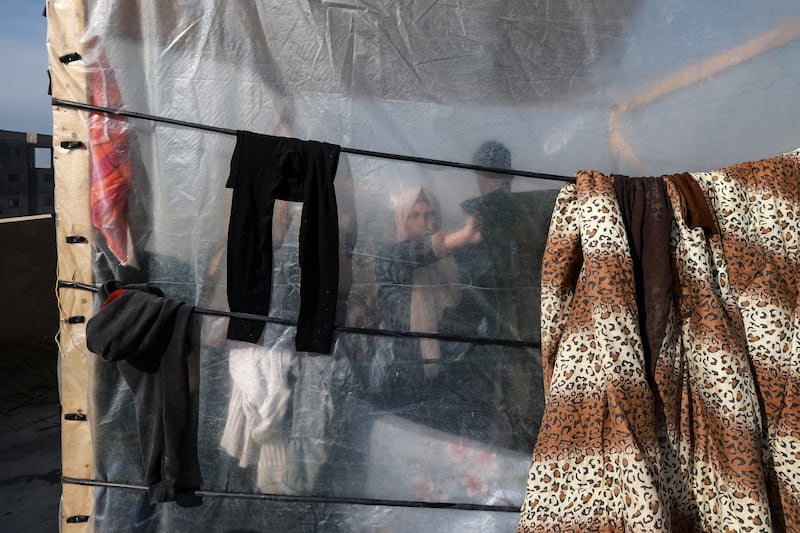After two months of war in Gaza, most of its people are homeless, crammed by a pounding Israeli bombardment into yet smaller areas of an already tiny enclave where the elderly and newborns live alike in tents amid the rubble.
Three women pushed from their homes in the Gaza Strip over 61 days of fighting have now ended up desperate for shelter and safety after fleeing from one place to another under air strikes and shellfire.
Zainab Khalil (57), is seeking to move for a fourth time as Israeli tanks roll into the southern city of Khan Younis. Israa al-Jamala (28), lives in a tent tending her infant daughter who was born the night a short-lived truce began. And Mai Salim walks by the Egyptian border fearing she and her family will be forced across it into a life of permanent exile.
Most of Gaza’s 2.3 million people were taken unaware by the sudden disaster that began to unfold on October 7th as Israeli jets began strikes to retaliate for a surprise Hamas attack across the border that Israel says killed 1,200 people, mostly civilians.
READ MORE
The Israeli military has vowed to crush Hamas, the Islamist movement that rules Gaza and is pledged to Israel’s destruction, but says the group hides its weapons, command centres and fighters among a civilian population it uses as “human shields”. Hamas denies this.
Four-fifths of Gaza residents have now been displaced, many of them several times over. Their homes, businesses, mosques and schools have been damaged, destroyed or abandoned in the face of the Israeli assault. Health authorities in Hamas-run Gaza say 17,177 people have been killed there.
With no real sign of any imminent respite, Palestinians are living with little food or clean water, often on the street, trying to calm screaming children at night as bombs and shells fall.
“A new mother should be in her home raising the child with her mother, with her family,” said Jamala, cradling her tiny daughter, also called Israa, amid the tents that have sprang up around a hospital in Deir al-Balah in central Gaza.
After the Jamala home was shelled, the family moved into the makeshift camp outside Shuhada al-Aqsa hospital, she said. Little Israa was born there on November 24th, the night a weeklong truce began, raising hope that the conflict might relent.
But after a week, fighting resumed and the family remains in the tent, a carpet covering the sand and Israa sleeping in a small cot.
Like others in Gaza they struggle to find food and other necessities. “See how much we're in need. There's no milk. No powdered milk,” Jamala said.
Even when the war finally ends, she does not know what she will do as their home was shelled. “Where will we stay? Where can we raise this baby? Where can we live?” she said.
Khalil lived in Sheikh Radwan, a suburb of Gaza City near Beach Refugee Camp in the enclave’s north. Israel started telling residents to go south in mid-October, though it continued with air strikes across the territory.
She did not want to leave, calling it the most difficult decision of her life. She finally moved to a shelter nearby where she thought she would be safer from bombardment, but as air strikes intensified over 10 days she decided to move on.
“A journey mixed with fear, despair, displacement and sadness under heavy bombardment,” was how she described her odyssey from shelter to shelter.

When Israeli troops pushed into Gaza City and surrounded al-Shifa Hospital, she headed south with a friend and her family, alternately walking and riding in a donkey cart.
As they crossed a front line, Israeli soldiers ordered them to “walk a bit and stop, walk and stop” over four hours, she said.
She wound up living in a school in Khan Younis being used as a shelter for about 30 displaced people, where some of her nieces had already ended up. “In this war, who doesn’t get killed by bombs gets killed by disease, sadness and despair,” she said.
But Israel’s military is now ordering people in Khan Younis to leave and Khalil must look for a new place to stay.
The only big town left to run to is Rafah, hard against the border with Egypt. Most Gaza residents are descended from refugees who fled or were forced from their homes in what is now Israel during the war of 1948. Many are terrified they will end up as refugees again, forced from Gaza altogether.
[ Much of Gaza’s cultural heritage has been destroyed or damaged by Israeli attacksOpens in new window ]
Walking by the border fence, Salim and a friend peered over towards Egypt. She had fled her home in Gaza City, moving first to Nuseirat and later to Khan Younis before finally ending up in Rafah after the Israeli military ordered people to move again.
“For us, this is the last stop. After that, if they want to forcibly displace us we will not leave. They can kill us right here but we will not leave our land and our entire lives. We will not do that,” she said. – Reuters














